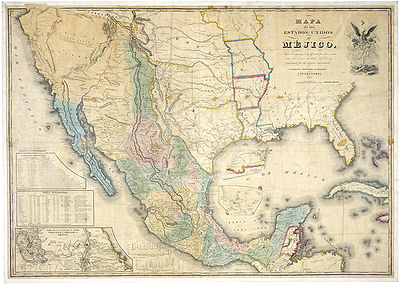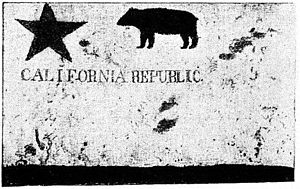- Conquest of California
-
Main article: Mexican American WarCalifornia Campaign
The "Conquest of California" or Conquest of Alta California by the United States covers the initial 1846 period of the Mexican-American War in Alta California, the present day state of California, United States. The Conquest of California was marked by a series of small battles over 1846.
Contents
History
Beginnings
When war was declared on May 13, 1846, between the United States and Mexico, it took almost two months (mid-July 1846) for definite word of war to get to California. U.S. consul Thomas O. Larkin, stationed in Monterey, on hearing rumors of war tried to keep peace between the Americans and the small Mexican military garrison commanded by José Castro. American army captain John C. Frémont with about 60 well-armed men had entered California in December 1845 and was making a slow march to Oregon when they received word that war between Mexico and the U.S. was imminent.[1]
Bear Flag Revolt
On June 15, 1846, some 30 settlers, mostly Americans, staged a revolt and seized the small Mexican garrison in Sonoma. They made up a flag and raised the "Bear Flag" over Sonoma. Days later the U.S. Army, led by Fremont, took over on June 23. The California state flag today is based on this original Bear Flag, and continues to contain the words "California Republic." No government was ever organized but the Bear Flag Revolt has become part of the state's folklore.
Prior to the Mexican-American War rumors of a possible conflict led to the U.S. Pacific Squadron being extensively reinforced till it had roughly half the U.S. Navy's ships. Since it took 120 to over 200 days to sail from the ports on the east coast around Cape Horn to the ports in Hawaii and California these movements had to be made well in advance of any possible conflict to be effective. Initially with no United States ports in the Pacific, the squadron's ships operated out of storeships which provided naval supplies and purchased food and obtained water from local ports of call in the Hawaiian Islands and on the Pacific coast. Their orders were in the event of war to capture the ports and cities of California. Commodore John Drake Sloat, commander of the Pacific Squadron, on hearing of a possible state of war between Mexico and the United States and the Bear Flag Revolt in Sonoma, ordered his naval forces to start occupying ports in Northern California. The ships USS Savannah with USS Cyane and USS Levant captured the Alta Californian capital city of Monterey on 7 July 1846 without firing a shot. Two days later on 9 July, USS Portsmouth captured San Francisco (then Yerba Buena) without firing a shot. On July 15, Sloat transferred his command to Commodore Robert F. Stockton, a much more aggressive leader. Definitive news reached Stockton in July that war had been declared between the U. S. and Mexico. Stockton's Pacific Squadrons 400 to 650 Marines and Blue Jackets (sailors), taken from several ships, were the only major U. S. ground force in California. The rest of Stockton's men were needed to man his vessels. To supplement his small force of Marines and sailors Commodore Stockton authorized John C. Frémont of the U. S. Army's Corps of Topographical Engineers to organize a volunteer militia of about 160 men—the California Battalion. They were to act primarily as occupation forces to free up Stockton's Marines and sailors. The California Battalion's core was based in large part around the approximate 30 army personnel and 30 scouts, guards,ex-fur trappers, Indians, geographers, topographers and cartogaphers in Fremont's exploration force. The American Marines, sailors and militia easily took over the cities and ports of northern California; within days they controlled Monterey, San Francisco, Sonoma, Sutter's Fort in Sacramento and other small towns in Northern California. Nearly all were occupied without a shot being fired. The southern cities and ports rapidly followed suit with almost no blood shed.
Californios and the war
Prior to the U.S. occupation there were approximately 1,500 local Hispanic men (and about 6,500 women and children), commonly called Californios, primarily located in Southern California around Los Angeles.[2] Many of these, lived on the 455 ranchos that had slightly more than 8,600,000 acres (35,000 km2) claimed (nearly all bestowed by the local governor to friends) averaging about 18,900 acres (76 km2) each. Most of the over 2,000 American immigrants (nearly all adult males) lived in the northern half of California. Most of them approved of the change in government and gave only token resistance to Stockton and Fremont's forces.[3]
Battle in Los Angeles
In Southern California, Mexican General José Castro and Governor Pío Pico fled from Los Angeles. When Stockton's forces entered Los Angeles unresisted on August 13, 1846, the nearly bloodless conquest of California seemed complete. Stockton, however, left too small a force (36 men) in Los Angeles, and the Californios, acting on their own and without help from Mexico, led by José Mariá Flores, forced the small American garrison to retire in late September.
Soon afterwards, 200 reinforcements sent by Stockton, led by US Navy Captain William Mervine were repulsed in the Battle of Dominguez Rancho on October 7–9, near San Pedro, where 14 U.S. Marines were killed. Meanwhile, General Kearny with a much reduced squadron of 100 dragoons finally reached California after a grueling march across New Mexico, Arizona and the Sonoran Desert. On December 6, 1846, they fought the Battle of San Pasqual near San Diego, California, where 18 of Kearny's troop were killed—the largest American casualties lost in battles in California.
Final conquest
Stockton rescued Kearny's surrounded forces and with their combined force, they moved northward from San Diego, entering the Los Angeles Basin area on January 8, 1847, linking up with Frémont's men and with American forces totaling 660 troops, they fought the Californios in the Battle of Rio San Gabriel and the next day they fought the Battle of La Mesa. The last significant body of Californios surrendered to American forces January 12, 1847, marking the end of the war in California.
After the Conquest of California
Treaty of Cahuenga
The "Treaty of Cahuenga" was signed on January 13, 1847, and essentially terminated hostilities in California. The treaty was drafted in English and Spanish by José Antonio Carrillo, approved by American Lieutenant-Colonel John C. Frémont and Mexican Governor Andrés Pico at Campo de Cahuenga in what is now North Hollywood, Los Angeles, California. It was later ratified by Fremont's superiors: Commodore Robert F. Stockton and General Stephen Kearny (brevet rank).
California Reinforcements
In July 1846, Colonel Jonathan D. Stevenson of New York was asked to raise a volunteer regiment of ten companies of 77 men each to go to California with the understanding that they would be muster out and stay in California. They were designated the 1st Regiment of New York Volunteers and took part in the California Campaign and the Pacific Coast Campaign. In August and September 1846 the regiment trained and prepared for the trip to California. Three private merchant ships, Thomas H Perkins, Loo Choo, and Susan Drew, were chartered, and the sloop USS Preble was assigned convoy detail. On 26 September the four ships sailed for California. Fifty men who had been left behind for various reasons sailed on 13 November 1846 on the small storeship USS Brutus. The Susan Drew and Loo Choo reached Valparaíso, Chile by 20 January 1847 and they were on their way again by 23 January. The Perkins did not stop until San Francisco, reaching port on 6 March 1847. The Susan Drew arrived on 20 March and the Loo Choo arrived on 26 March 1847, 183 days after leaving New York. The Brutus finally arrived on 17 April 1847.
After desertions and deaths in transit the four ships brought 648 men to California. The companies were then deployed throughout Upper-Alta and Lower-Baja California (captured by the Navy, but later negotiated away) from San Francisco to La Paz, Mexico. The ship Isabella sailed from Philadelphia on 16 August 1846, with a detachment of one hundred soldiers, and arrived in California on 18 February 1847, the following year, at about the same time that the ship Sweden arrived with another detachment of soldiers. These soldiers were added to the existing companies of Stevenson's 1st New York Volunteer Regiment.[4] These troops essentially took over nearly all of the Pacific Squadron's on-shore military and garrison duties and the California Battalion's garrison duties.
The Mormon Battalion served from July 1846 to July 1847 during the Mexican-American War. The battalion was a volunteer unit of between 534[5][6] and 559[7] Latter-day Saints men were led by Mormon company officers, commanded by regular United States Army senior officers. During its service, the battalion made a grueling march, at nearly 2,000 miles in length from Council Bluffs, Iowa to San Diego, California. This remains one of the longest single military march in U.S. history.
The Mormon Battalion arrived in San Diego, California on January 29, 1847, after a march of some 1,900 miles from Iowa. For the next five months until their discharge on July 16, 1847 in Los Angeles, the battalion trained and did garrison duties in several locations in southern California before their discharge. Discharged members of the Mormon Battalion were helping build a sawmill for John Sutter when gold was discovered there in January 1848 starting the California Gold Rush.
In January 1847 Army lieutenant William Tecumseh Sherman and about 100 regular U.S. Army soldiers arrived in Monterey. American forces in the pipeline continued to dribble into California.
Treaty of Guadalupe Hidalgo
The Treaty of Guadalupe Hidalgo, signed in February, 1848, marked the end of the Mexican-American War. In that treaty Mexico formally ceded Alta California and its other northern territories east through Texas for $15,000,000. This largely unsettled territory constituted nearly half of its claimed territory with about 1% (about 45,000) of its then population of about 4,500,000.[8][9]
See also
- Category: California Campaign - Mexican American War
- History of California to 1899
Further reading
- Hubert Howe Bancroft. The Works of Hubert Howe Bancroft, vol 22 (1886), History of California 1846-48; complete text online; famous, highly detailed narrative written in 1880s. Also at History of California,VOL. V. 1846-1848
- Harlow, Neal California Conquered: The Annexation of a Mexican Province 1846–1850, ISBN 0-520-06605-7, (1982)
- Hittell, Theodore Henry. History of California vol 2 (1885) online
- Nevins, Allan. Fremont: Pathmarker of the West, Volume 1: Fremont the Explorer (1939, rev ed. 1955)
- Rawls, James and Walton Bean. California: An Interpretive History (8th ed 2003), college textbook; the latest version of Bean's solid 1968 text
Notes
- ^ http://www.militarymuseum.org/fremont.html
- ^ Californios [1] Accessed 25 July 2009
- ^ Theodore Henry Hittell, History of California vol. 2 (1885) online
- ^ Seventy-five Years in San Francisco; Appendix L [2] Accessed 18 Mar 2009
- ^ http://historytogo.utah.gov/utah_chapters/trappers,_traders,_and_explorers/mormonbattalion.html
- ^ http://californiapioneer.org/historic-events/mormon-battalion
- ^ http://www.ldschurchnews.com/articles/22116/Monument-honoring-Mormon-Battalion-to-regain-its-luster.html
- ^ Note: A new international boundary was drawn; San Diego Bay is one of the only two main natural harbors in California south of San Francisco Bay; the border was aligned from one Spanish league south of San Diego Bay east to the Gila River – Colorado River confluence, to include strategic San Diego and its harbor.
- ^ Two years after the Treaty of Guadalupe Hidalgo, U.S. statehood was granted in 1850.
History of California to 1899 Precontact · First explorations · Later explorations · Spanish colonization · Russian colonization · Mexican rule · California Trail · Mexican-American War · U.S. rule · Gold Rush · Civil War
since 1900 By topic By city Los Angeles · Riverside · Sacramento · San Bernardino · San Diego · San Francisco · San Jose
Categories:- California Campaign
- Mexican–American War
- Mexican California
- Pre-state history of California
- History of United States expansionism
Wikimedia Foundation. 2010.


